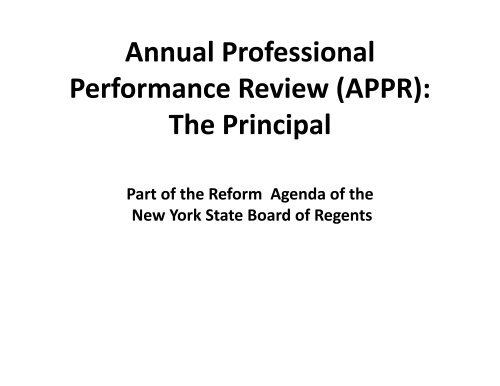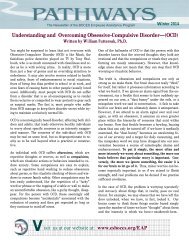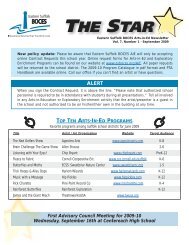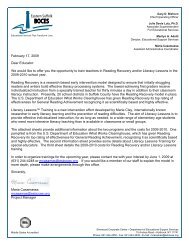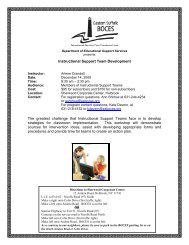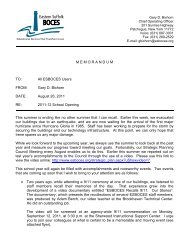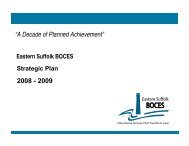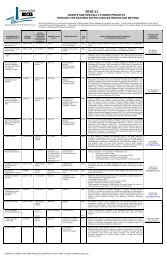Day 5 Principal Evaluation Training.pdf - Eastern Suffolk BOCES
Day 5 Principal Evaluation Training.pdf - Eastern Suffolk BOCES
Day 5 Principal Evaluation Training.pdf - Eastern Suffolk BOCES
Create successful ePaper yourself
Turn your PDF publications into a flip-book with our unique Google optimized e-Paper software.
Annual Professional<br />
Performance Review (APPR):<br />
The <strong>Principal</strong><br />
Part of the Reform Agenda of the<br />
New York State Board of Regents
Turnkey <strong>Training</strong> for <strong>Principal</strong><br />
Evaluators and Lead Evaluators<br />
Presented by <strong>Eastern</strong> <strong>Suffolk</strong><br />
<strong>BOCES</strong><br />
2
<strong>Day</strong> 5<br />
Using the SLO Rating Rubric and<br />
Understanding the SLO and HEDI<br />
Rating
Workshop Objectives<br />
Participants will:<br />
• Use a quality rating system to ensure and<br />
improve the rigor and comparability of SLOs.<br />
• Discuss ways to ensure inter‐rater reliability<br />
in the SLO rating process to further<br />
consistency, equity, and fairness.<br />
• Experience nuanced aspects of the SLO<br />
process such as developing school SLOs and<br />
weighting multiple SLOs<br />
• Understand the <strong>Principal</strong>’s role in the SLO<br />
process
SLO Connections to ISLLC<br />
ISLLC Standard 1<br />
• An education leader promotes the<br />
success of every student by facilitating<br />
the development, articulation and<br />
stewardship of a vision of learning that<br />
is shared by all stakeholders.<br />
SLO Connection<br />
• SLOs are part of the plans for making<br />
this vision of learning a reality for all<br />
students.<br />
5
6<br />
A Sample SLO Process Flow
SLO Process Flow – The <strong>Principal</strong>’s<br />
Role<br />
There are four parts or hooks to the SLO Process<br />
Flow... PREPARATION, DEVELOPMENT,<br />
IMPLEMENTATION, AND RESULTS/ANALYSIS.<br />
Activity:<br />
• In each of your groups, focus on the area of the<br />
process flow chart assigned to find the places<br />
where the high level of participation of the<br />
principal is most critical. How will this make the<br />
implementation of SLOs better?<br />
7
District Decisions<br />
1. Assess and identify district‐priorities and academic<br />
needs.<br />
2. Identify who will have State‐provided growth<br />
measures and who must have SLOs as “comparable<br />
growth measures.”<br />
3. Determine district rules for how specific SLOs will be<br />
set.<br />
4. Establish expectations for scoring SLOs and for<br />
determining teacher ratings for the growth<br />
component.<br />
5. Determine district‐wide processes for setting,<br />
reviewing, and assessing SLOs in schools.<br />
8
District Decisions –Micro‐decisions<br />
• Review the micro‐decisions document<br />
• These decisions present “unpacked” district<br />
decisions to make regarding SLOs<br />
• We will work through one example together and<br />
highlight a few key decisions that need to be made.<br />
• Activity:<br />
We will assign a portion of the document for<br />
discussion and review by your group. We will<br />
also review all sections for all participants.<br />
9
10<br />
Micro‐decisions (at‐a‐glance)
11<br />
Micro‐decisions (at‐a‐glance)
12<br />
Micro‐decisions (at‐a‐glance)
District Decisions –Micro‐decisions<br />
• Learning Content –Whole versus Part<br />
• Who will decide whether part or all of the course standards<br />
will be included in the SLO? (This applies to areas where a<br />
choice exists, so State assessments are not included here.)<br />
•<br />
• District Staff<br />
• <strong>Principal</strong><br />
• Teacher<br />
• Other<br />
13<br />
What are the advantages and disadvantages of each<br />
choice?
14<br />
District Decisions –Micro‐decisions<br />
Courses with<br />
a summative<br />
assessment<br />
Courses<br />
without a<br />
summative<br />
assessment<br />
Create/select an additional assessment (This<br />
is not permitted if using a State assessment.)<br />
Remain with one summative<br />
Create a summative<br />
Purchase a summative<br />
Attribute points based on school‐ or <strong>BOCES</strong>‐<br />
wide, group/team results on State<br />
assessments ( (This will be an SLO.) )
•<br />
15<br />
Introduction to the Rubric
•<br />
16<br />
Introduction to the Rubric
•<br />
17<br />
Introduction to the Rubric
•<br />
18<br />
Introduction to the Rubric
•<br />
19<br />
Introduction to the Rubric
•<br />
20<br />
Introduction to the Rubric
•<br />
21<br />
Introduction to the Rubric
22<br />
Annotated SLO Rubric Form
23<br />
Annotated SLO Rubric Form
Introduction to the Rubric<br />
• Proposed uses of the rubric<br />
• Network Teams<br />
• <strong>BOCES</strong> guidance and monitoring<br />
• District guidance and monitoring<br />
• School/principal guidance<br />
• Teacher guidance<br />
24
Learning Content<br />
This is the content to be taught in the SLO.<br />
Task:<br />
Identify the course name and source of<br />
standards (Common Core, national, state, local)<br />
associated with this SLO, and specify the exact<br />
standards, performance indicators, etc., that<br />
will be taught, learned, and assessed.<br />
25
Learning Content – Quality Rating 2<br />
• Identifies course name.<br />
• Uses the appropriate body of standards<br />
(Common Core, national, state, local).<br />
• Names the exact standards, performance<br />
indicators, etc.<br />
26
Learning Content – Quality Rating 3<br />
Meets all of the following:<br />
• Meets the Quality Rating 2 criteria.<br />
• Selects specific and measurable standards,<br />
indicators, etc.<br />
• Selects the most important standards,<br />
indicators, etc. for the course.<br />
• Includes Common Core standards to supplement<br />
NYS Learning Standards for courses other than<br />
ELA or math (e.g., Literacy in History/Social<br />
Studies, Science, and Technical Subjects).<br />
27
Learning Content – Quality Rating 3<br />
Meets one or both of the following:<br />
• Aligns to district and/or school priorities.<br />
• Aligns to future coursework, as well as college<br />
and career readiness.<br />
28
29<br />
Global II Regents SLO
30<br />
Global II Regents SLO
31<br />
Global II Regents SLO
32<br />
Global II Regents SLO Rosters
Learning Content – <strong>Training</strong> SLO<br />
Activity:<br />
• Using the Annotated SLO Rubric Form, assign<br />
a quality rating to the sections on the training<br />
SLO: Global II Regents SLO on your own<br />
• Discuss the rating with your group, and decide<br />
on a final quality rating for this element. Was<br />
there much disagreement? If so, what were<br />
the sticking points?<br />
33
• Activity:<br />
Applying the SLO Rubric<br />
Use the rubric to find quality ratings for the<br />
provided SLO(s).<br />
7 th Grade Visual Arts, Grade 2 ELA,<br />
Instrumental Music Grade 5, Physical education<br />
9‐12, ELA 9 Self‐contained Special Education<br />
34
SLO Scoring<br />
• Review the Grade 7 Visual Arts SLO and its<br />
completed roster (where actual summative<br />
scores are now recorded)<br />
• Note the number of students who achieved<br />
their targets<br />
• In light of the established HEDI, this teacher<br />
earned 14 points for the State growth portion<br />
of the teacher evaluation<br />
35
SLO Scoring<br />
• Count students in SLO 105<br />
• Subtract number who did not take summative 8<br />
• Find number of students with two points in time 97<br />
• Count number of students making their targets 78<br />
(19 students did not make their targets)<br />
• Compute percent of students achieving targets<br />
(count those making target/number of students) (78/97) * 100 = 80.41%<br />
Rounded = 80%<br />
• Compare to HEDI structure: 80% = 14 points<br />
(Effective)<br />
36
Activity:<br />
SLO Scoring<br />
• Review the Grade 2 ELA and Global II SLOs and their<br />
completed rosters.<br />
• Note the number of students who achieved their<br />
targets.<br />
• In light of each established HEDI, determine how many<br />
points earned for the State growth portion of each<br />
teacher’s evaluation.<br />
37
SLO Scoring –Grade 2 ELA SLO<br />
• Count students in SLO 23<br />
• Subtract number who did not take summative 2<br />
• Find number of students with two points in time 21<br />
• Count number of students making their targets 15<br />
(6 students did not make their targets)<br />
• Compute percent of students achieving targets (15/21) * 100 =<br />
71.4%<br />
• (count those making target/number of students) Rounded = 71%<br />
• Compare to HEDI structure: 71% = 4 points (Developing)<br />
38
SLO Scoring –Global II Regents SLO<br />
• Count students in SLO 60<br />
• Subtract number who did not take summative 4<br />
• Find number of students with two points in time 56<br />
• Count number of students making their targets 50<br />
(6 students did not make their targets)<br />
• Compute percent of students achieving targets (50/56) * 100 = 89.2%<br />
(count those making target/number of students) = Rounded = 89%<br />
• Compare to HEDI structure: 89% = 18 points (Highly Effective)<br />
39
Weighting Multiple Assessments<br />
• Review the Grade 7 Visual Arts SLO<br />
• If another measure were used for evidence, such as<br />
a multiple choice, the two measures would need to<br />
be weighted<br />
• In this case, we may want to weight the<br />
performance assessment more, such as 80%, since it<br />
is a more authentic measure<br />
• The weighting would be articulated in the SLO<br />
• Though two scores would be generated, only the<br />
overall score(s) need to be listed on file<br />
40
Weighting Multiple Assessments<br />
Activity:<br />
• Review the Grade 2 ELA and Global II SLOs.<br />
• Discuss briefly which types of assessments may<br />
best supplement each of these two SLOs, and how<br />
they may be weighted.<br />
41
Weighting Multiple SLOs<br />
• Review the Grade 7 Visual Arts SLO<br />
• Keeping in mind this SLO involved 97 students (with<br />
pre‐and summative scores) and earned a HEDI point<br />
value of 14, let’s change the scenario. The Grade 7<br />
Visual Arts teacher now had a second SLO involving 29<br />
students, which earned a HEDI of 18 points<br />
• How many points has the teacher earned for the State<br />
growth portion of the evaluation?<br />
42
Weighting Multiple SLOs – Grade 7<br />
• Sum of the number of students<br />
97 + 29 = 126<br />
Visual Arts<br />
• Compute the proportion of students covered by each SLO<br />
97/126 = .7698<br />
29/126 = .2302<br />
• Multiply the proportion by the HEDI points for two partial HEDIs<br />
that will be added together. (We are weighting the overall HEDI<br />
by the number of students.)<br />
.7698 * 14 = 10.7772<br />
.2302 * 18 = 4.1436<br />
• Overall HEDI = sum of these partial HEDI values<br />
10.7772 + 4.1436 = 14.9208<br />
Rounded = 15 (Effective)<br />
43
SLOs for Group/Team, School, <strong>BOCES</strong><br />
Results<br />
• Review Page 1 of the Purple Memo<br />
• In the absence of assessments, certain teachers may<br />
earn up to 20 points for State growth via group‐, team,<br />
school‐, or <strong>BOCES</strong>‐level result.<br />
• Ensure the rationale for taking this approach with<br />
teacher groups is strong.<br />
• Let’s look at an SLO set for all arts teachers at Sample<br />
Middle School<br />
44
SLOs for Group/Team, School, <strong>BOCES</strong><br />
Results<br />
Population: All students in the 6 th , 7 th , and 8 th grade ELA courses<br />
at Sample Middle School<br />
• Learning Content: All NYS P12 CCLS for ELA and Literacy in<br />
grades 6, 7, and 8<br />
• Evidence: The NYS ELA assessment for grade 6, 7, and 8<br />
• Baseline: Student performance on last year’s ELA assessments<br />
showed school proficiency rates of 56%, 60%, and 62% for<br />
grades 5, 6, and 7 respectively (Grade 5 proficiency rates<br />
calculated based on average of feeder schools)<br />
45
SLOs for Group/Team, School, <strong>BOCES</strong><br />
Results<br />
• Targets: The average growth in ELA proficiency for students in grades 6, 7, and 8 will<br />
increase by 5%<br />
• HEDI:<br />
Highly effective: Average growth is 6.5% or higher<br />
HIGHLY<br />
EFFECTIVE<br />
46<br />
Effective: Average growth is 4.5% ‐ 6.4%<br />
Developing: Average growth is 2.5% ‐ 4.4%<br />
Ineffective: Average growth is 2.4% or less<br />
EFFECTIVE DEVELOPING INEFFECTIVE<br />
20 19 18 17 16 15 14 13 12 11 10 9 8 7 6 5 4 3 2 1 0<br />
7.5<br />
and<br />
above<br />
7.0-<br />
7.4<br />
6.5-<br />
6.9<br />
6.3-<br />
6.4<br />
6.1-<br />
6.2<br />
5.9-<br />
6.0<br />
5.7-<br />
5.8<br />
5.3-<br />
5.6<br />
5.1-<br />
5.2<br />
4.9-<br />
5.0<br />
4.7-<br />
4.8<br />
4.5-<br />
4.6<br />
4.3-<br />
4.4<br />
4.1-<br />
4.2<br />
3.5-<br />
4.0<br />
2.9-<br />
3.4<br />
2.7-<br />
2.8<br />
2.5-<br />
2.6<br />
2.0-<br />
2.4<br />
1.5-<br />
1.9<br />
1.4<br />
or<br />
less
SLOs for Group/Team, School, <strong>BOCES</strong><br />
Results<br />
• Interval: September 4, 2012 through April 19, 2013<br />
• Rationale:<br />
• Students enrolled in the arts courses at Sample Middle School will engage<br />
in literacy‐infused instruction and be exposed to ELA standards through<br />
the arts<br />
47<br />
• The evidence of the State assessment is directly tied to the students’<br />
ongoing work and learning in the arts by way of assessing ELA skills taught<br />
in the arts<br />
• The targets are rigorous, as our school ELA performance usually only<br />
climbs 1 or 2 percentage points a year<br />
• Students will read about artists studied, record text‐based responses, and<br />
engage in other ELA activities which will be recorded in their learning<br />
folios
SLOs for Group/Team, School, <strong>BOCES</strong><br />
Activity:<br />
Results<br />
• Craft an SLO for a teacher group based on<br />
group/team‐, school‐, or <strong>BOCES</strong>‐level performance.<br />
48
SLO Process Assessment Tool<br />
• Most/all principals are charged with leading the<br />
SLO process for their schools.<br />
• We have developed the following SLO Process<br />
Assessment Tool to qualify various levels of<br />
effective levels of SLO implementation.<br />
• Let’s review the structure and purpose of the SLO<br />
Process Assessment Tool<br />
49
50<br />
SLO Process Assessment Tool
51<br />
SLO Process Assessment Tool
52<br />
SLO Process Assessment Tool
53<br />
SLO Process Assessment Tool
54<br />
SLO Process Assessment Tool
55<br />
SLO Process Assessment Tool
56<br />
SLO Process Assessment Tool
The <strong>Principal</strong>’s Work<br />
in the SLO Process<br />
• Activity:<br />
Examine the case study and using the SLO<br />
Process Assessment Tool, and the rubric<br />
your district is using or considering, try to<br />
evaluate the principal’s work in the<br />
section of the SLO process your group is<br />
assigned.<br />
How did the principal do?
How Does the Work Get Done?<br />
• Activity: Discuss your district’s organizational<br />
structure with your group. Who will be<br />
responsible for each section of the SLO<br />
process? How is the work distributed? Who<br />
will supervise or review the work done?<br />
Remember the four parts or hooks of the SLO<br />
Process Flow…PREPARATION, DEVELOPMENT,<br />
IMPLEMENTATION AND RESULTS/ANALYSIS.
Tool Sharing: School SLO Calendars<br />
59
60<br />
Tool Sharing: School SLO Calendars
Year in Review: School Reflection<br />
• It is helpful to reflect on the SLO processes<br />
at the end of the year to inform and<br />
improve next year’s implementation.<br />
• Let’s look at some data displays intended to<br />
generate ideas for which data points a<br />
school may wish to document.<br />
61
Year in Review: School Reflection<br />
• Activity:<br />
62<br />
Take some time to review the data and<br />
reflect on implications for next year’s SLO<br />
process.<br />
Craft a potential plan of action resulting<br />
from the data and its implications.
Teacher Name<br />
63<br />
Content area<br />
School Reflection: Sample Data<br />
Grade<br />
Target statement<br />
Approver<br />
Actual SLO<br />
success rate<br />
HEDI rating<br />
by SLO<br />
Final<br />
HEDI rating*<br />
State test results -<br />
Proficiency<br />
Learning Content<br />
Evidence<br />
Baseline<br />
Targets<br />
Population<br />
HEDI<br />
Interval<br />
Rationale<br />
A ELA 2 80% will grow by 30 points AP 75% 8 12 n/a 3 3 2 3 2 2 2 3<br />
A Math 2 80% will grow by 20 points PR 83% 16 12 n/a 2 3 2 2 2 2 2 2<br />
B ELA 1 80% will grow by 40 points AP 76% 9 13 n/a 3 2 3 3 2 2 2 3<br />
B Math 1 80% will grow by 20 points PR 85% 18 13 n/a 2 2 2 2 2 2 2 2<br />
C ESL-coteach 2 80% will grow by 30 points AP 78% 11 11 n/a 3 3 2 3 2 2 2 3<br />
D ELA 3 80% will grow by 40 points AP 62% 0 2 63% 2 3 2 2 2 2 2 2<br />
D Math 3 80% will grow by 20 points PR 70% 3 2 62% 2 3 2 2 2 2 2 2<br />
E ELA 2 80% will grow by 30 points AP 79% 12 16 n/a 3 3 3 3 2 2 2 3<br />
E Math 2 80% will grow by 20 points PR 92% 20 16 n/a 2 3 2 2 2 2 2 2<br />
F ELA 1 80% will grow by 40 points AP 69% 2 7 n/a 3 2 2 2 2 2 2 2<br />
F Math 1 80% will grow by 20 points AP 78% 11 7 n/a 2 2 2 2 2 2 2 2<br />
G ELA K 80% will grow by 40 points AP 76% 9 11 n/a 3 3 3 3 2 2 2 3<br />
G Math K 80% will grow by 20 points PR 80% 13 11 n/a 2 2 2 2 2 2 2 2<br />
H ELA 3 80% will grow by 40 points AP 92% 20 20 90% 3 3 3 3 2 3 2 3<br />
H Math 3 80% will grow by 20 points PR 94% 20 20 85% 3 3 3 3 2 3 2 3<br />
I ELA 2 80% will grow by 30 points AP 74% 7 13 n/a 3 3 3 3 2 2 2 3<br />
I Math 2 80% will grow by 20 points PR 87% 18 13 n/a 2 3 2 2 2 2 2 2<br />
J ELA 1 80% will grow by 40 points AP 77% 10 15 n/a 3 2 3 3 2 2 2 3<br />
J Math 1 80% will grow by 20 points PR 92% 20 15 n/a 2 2 2 2 2 2 2 2<br />
* HEDI rating is based on two equal sized classes Quality Rating Obtained
64<br />
<strong>Principal</strong><br />
Highly Effective Effective<br />
Developing Ineffective<br />
School Reflection:<br />
Sample HEDI Ratings<br />
Assistant <strong>Principal</strong><br />
Highly Effective Effective<br />
Developing Ineffective
Year in Review: District Reflection<br />
• It is helpful to reflect on the SLO processes<br />
at the end of the year to inform and<br />
improve next year’s implementation.<br />
• Let’s look at some data displays intended to<br />
generate ideas for which data points a<br />
district may wish to document.<br />
65
Year in Review: District Reflection<br />
• Activity:<br />
• Take some time to review the data and<br />
reflect on implications for next year’s SLO<br />
process.<br />
• Craft a potential plan of action resulting<br />
from the data and its implications.<br />
66
67<br />
250<br />
200<br />
150<br />
100<br />
50<br />
0<br />
District Reflection:<br />
Sample HEDI Ratings<br />
HEDI Distribution: State 20%<br />
ELA Math Social Studies Science<br />
Highly Effective Effective Developing Ineffective
68<br />
300<br />
250<br />
200<br />
150<br />
100<br />
50<br />
0<br />
District Reflection:<br />
Sample HEDI Ratings<br />
HEDI Distribution: State 20%<br />
Arts Health, PE, FACS CTE LOTE<br />
Highly Effective Effective Developing Ineffective
Future training dates:<br />
<strong>Day</strong> 6 – August 9 Westhampton Beach<br />
Contact Information:<br />
Wendell Chu – wchu51@aol.com<br />
Alan Van Cott –avcott@aol.com<br />
69


